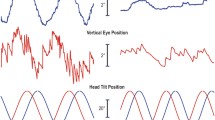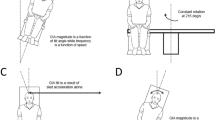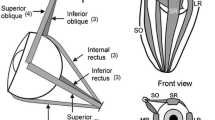Summary
Lateral eye movements evoked by linear head motion were evaluated in human subjects by subtracting the eye movement responses to headcentred angular oscillation in the dark, about a vertical axis, from the responses evoked by similar oscillation with the head displaced 30 cm eccentrically from the axis. The centred oscillation gave a purely angular stimulus whereas the eccentric oscillation gave an additional tangential linear acceleration acting laterally to the head. The stimuli used were relatively unpredictable, enveloped sinewaves at 0.02 to 1.2 Hz, 60°/s peak angular velocity, 0.004 to 0.24 g peak tangential acceleration, and subjects were either given no instructions or were told to imagine fixating on targets at 60 cm or 5 m distance. Eye movements of significantly higher velocity were evoked in the eccentric position, particularly at the higher frequencies and when subjects imagined near targets. The increase in velocity of eye movement was attributed to the linear stimulus and probably derives from stimulation of the otolith organs. The frequency response of the gain (°/s/g) of these movements gave an approximate slope of −1, indicating that the eye velocity bears a constant proportionality to linear head velocity. The findings are in accord with the theoretical prediction that eye movements compensating for linear head motion should only be required for viewing near targets. These otolithic influences on eye movements could either the mediated by a direct “otolith-ocular reflex” which is subservient to viewing conditions or, alternatively, the otolith signals may modify the activity of other oculomotor mechanisms.
Similar content being viewed by others
References
Barnes GR (1979) Vestibular mechanisms (review article). Clin Phys Physiol Meas 1: 3–40
Barr CC, Schultheis LW, Robinson DA (1976) Voluntary, non visual control of the human vestibular ocular reflex. Acta Otolaryngol 81: 365–375
Bronstein A, Hood JD (1986) The cervico-ocular reflex in normal subjects and patients with absent vestibular function. Brain Res 373: 399–408
Buizza A, Leger A, Droulez J, Berthoz A, Schmid R (1980) Influence of otolithic stimulation by horizontal linear acceleration on optokinetic nystagmus and visual motion perception. Exp Brain Res 39: 165–176
Eckmiller R (1982) Concerning the linear acceleration input to the neural oculomotor control system in primates. In: Roucoux A, Crommelinck M (eds) Physiological and pathological aspects of eye movements. Dr W Junk, The Hague Boston London, pp 131–137
Graybiel A (1974) Measurement of otolith function in man: F. Vestibular input-output relations. In: Kornhuber HH (ed) Vestibular system, Part 2: psychophysics, applied aspects and general interpretations. Handbook of sensory physiology, Vol VI. Springer, Berlin Heidelberg New York, pp 233–266
Gresty MA, Bronstein AM (1986) Otolith stimulation evokes compensatory reflex eye movements of high velocity when linear motion of the head is combined with concurrent angular motion. Neurosci Lett 65: 149–154
Gresty M, Barratt H, Bronstein A, Page N (1986) Clinical aspects of otolith-oculomotor relationships. In: Zee DS, Keller E (eds) Adaptive processes in visual and oculomotor systems. Pergamon Press, Oxford, pp 357–366
Guedry FE (1974) Psychophysics of vestibular sensation. IV A. Perceptions during changing horizontal linear acceleration. In: Kornhuber HH (ed) Vestibular system part 2: psychophysics, applied aspects and general interpretations. Handbook of sensory physiology, Vol VI. Springer, Berlin Heidelberg New York, pp 3–154
Lisberger SG, Evinger C, Johanson GW, Fuchs AF (1981) Relation between eye acceleration and retinal image velocity during foveal smooth pursuit in man and monkey. J Neurophysiol 46: 229–249
Parker DE, Reschke MF, Arrott AP, Homick JL, Lichtenberg BK (1985) Otolith tilt-translation reinterpretation following prolonged weightlessness: implications for preflight training. Aviat Space Env Med 56: 601–606
Author information
Authors and Affiliations
Additional information
A. M. Bronstein was supported by The Brain Research Trust
Rights and permissions
About this article
Cite this article
Gresty, M.A., Bronstein, A.M. & Barratt, H. Eye movement responses to combined linear and angular head movement. Exp Brain Res 65, 377–384 (1987). https://doi.org/10.1007/BF00236311
Received:
Accepted:
Issue Date:
DOI: https://doi.org/10.1007/BF00236311




